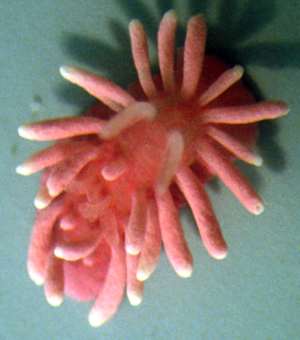
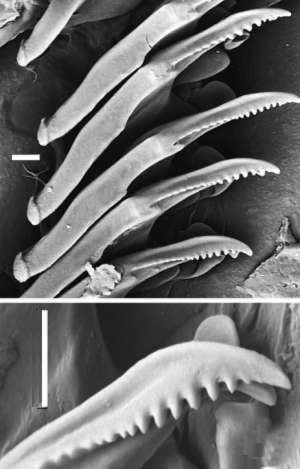
Okenia hiroi
(Baba, 1938)
Order: NUDIBRANCHIA
Suborder: DORIDINA
Superfamily: ANADORIDOIDEA
Family: Goniodorididae
DISTRIBUTION
Known from Pacific coast of Japan, Korea, China (Hong Kong).
PHOTO
Upper:Mirs Bay, Hong Kong, April 1982, AM C.133758. Photo: B.W. Darvell. Lower: SEM of radula showing (upper) inner teeth on right side. Note groove along the upper edge of the blade. Close-up (lower) shows tip of inner tooth with bifid cusp. Wai Kap Pai, Rocky Harbour, Hong Kong, 5–6m, 23 January 1983, AM C138136. Scale bar = 10 µm. Photo: G.
Avern.
NOTE: This species has previously been known on the Forum as Hopkinsia hiroi.
The animal has a low flattened profile and from above, the mantle, foot and head are merged into one, although ventrally a groove indicates the junction of the head and the foot. There are no oral tentacles. There are about 20 elongate lateral papillae around the body, indicating the edge of the mantle. There is no indication of symmetrical pairing of papillae as in some other species of Okenia. There are a few dorsal papillae, one in the midline, halfway between the gills and the rhinophores, and there is one on each side just behind this central one, forming a staggered transverse row. There are also a pair of papillae just behind the gills, one on each side. The arrangement of dorsal papillae is quite variable and there can be a few more or a few less than the basic 5. The rhinophores are similar in size and shape to the lateral papillae. There are 4 or 5 small gills forming an arch around the anal papilla. The whole of the animal is pink, matching the colour of the bryozoan on which it is feeding. The tips of all the dorsal processes, papillae and rhinophores are white. There is some variation in the intensity of the pink, and in some animals there is a considerable amount of white on the papillae. It grows to 10 mm in length.
The radula is fairly typical for the Goniodorididae but the inner lateral teeth have some unique features. They have a wide base and a long rod-like blade which narrows to a bicuspid tip. The cutting edge is lined with large bluntly rounded denticles, and there is a prominent shallow groove along the length of the blade. The much smaller outer teeth have a broad rounded base and up to 4 recurved pointed cusps along the outer edge of the tooth
Gosliner (2004) recently proposed synonymising the genera Hopkinsia and Hopkinsiella with Okenia. Like many of the 'Hopkinsia-group' of species, O. hiroi has a relatively broad flattened body in which the head and foot are fused, the lateral papillae are relatively large and crowded, and the body, like its food, is reddish pink. The inner radular teeth of this species have two interesting features that link it with both 'typical' species of Okenia and some more extreme forms. The teeth have a distinctive rounded groove along the upper edge of the blade which is also found in the unusually shaped Okenia stellata, and they also have a bicuspid tip, an unusual feature also found in O. pellucida, and O. purpureolineata. This grooved and bifid tooth may also indicate the origin of the strange tooth found in Okenia hallucigenia and Okenia kondoi in which the groove, the bifurcation, and the denticulation appear to have become greatly accentuated.
This species is often found associated with a similarly coloured encrusting bryozoan (Rudman & Darvell, 2001). This has recently been identified by Dr D.P. Gordon as a new species of Integripelta Gordon, Mawatari & Kajihara, 2002 (Eurystomellidae; Cheilostomata) (Rudman, 2004).
-
Baba,K. (1938) Opisthobranchia of Kii, Middle Japan. Journal of the Department of Agriculture, Kyusyu Imperial University, 6(1): 1-19.
-
Gosliner, T. M. (2004) Phylogenetic Systematics of Okenia, Sakishimaia, Hopkinsiella and Hopkinsia (Nudibranchia: Goniodorididae) with descriptions of new species from the tropical Indo-Pacific. Proceedings of the California Academy of Sciences, 55: 125-161.
-
Rudman, W.B. & Darvell, B.W. (1990) Opisthobranch molluscs of Hong Kong. Part 1. Goniodorididae, Onchidorididae, Triophidae, Gymnodorididae, Chromodorididae, (Nudibranchia). Asian Marine Biology, 7: 31-79.
-
Rudman, W.B. (2004) Further species of the opisthobranch genus Okenia (Nudibranchia: Goniodorididae) from the Indo-West Pacific. Zootaxa, 695: 1-70.
ARCHIVE NOTE: An earlier edition of this Fact Sheet [5 July 2001] as Hopkinsia hiroi is available on request.
Authorship detailsRudman, W.B., 2004 (December 21) Okenia hiroi (Baba, 1938). [In] Sea Slug Forum. Australian Museum, Sydney. Available from http://www.seaslugforum.net/find/hopkhiro
Related messages
Hopkinsia hiroi from Japan [1]
November 15, 2003
From: Yukari Sato
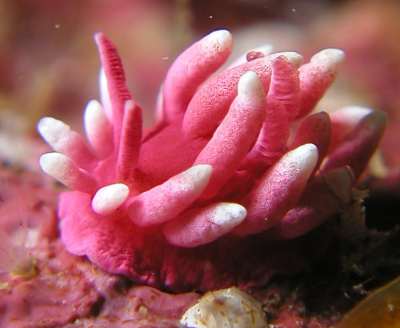
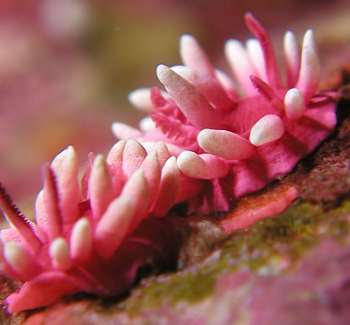
Hello Dr.Rudman,
Here are a some photos of Hopkinsia hiroi from Suruga Bay, west coast of Izu peninsula, Japan. I am happy if you have any comment.
Upper & lower photos of single animal:
Date: 21 May 2003
Depth: 18m
Size: 7mm.
Location: Tago, Suruga bay, west coast of Izu peninsula, Japan
Middle photo of two animals:
Date: 21 May 2003
Depth: 18m
Size: 7mm.
Location: Tago, Suruga bay west coast of Izu peninsula,Japan
Best regards,
Yukari Sato
yuks@cg7.so-net.ne.jp
Sato, Y., 2003 (Nov 15) Hopkinsia hiroi from Japan [1]. [Message in] Sea Slug Forum. Australian Museum, Sydney. Available from http://www.seaslugforum.net/find/11399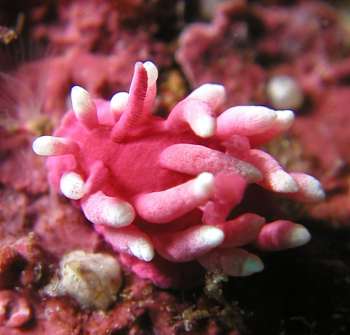
Thanks Yukari,
I guess the pink encrusting layer the animals are on is there bryozoan food
Best wishes
Bill Rudman
Hopkinsia hiroi from Japan [2]
November 15, 2003
From: Yukari Sato
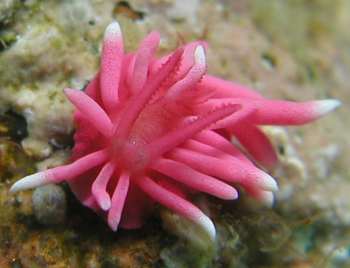
Hello Dr.Rudman,
Here are a some more photos of Hopkinsia hiroi from Suruga Bay, west coast of Izu peninsula, Japan. I am happy if you have any comment.
Upper & lower right:
Date: 11 Jun 2003
Depth: 3m
Size: approx.10mm.
Location: Shishihama, Suruga bay, west coast of Izu peninsula, Japan
Lower left:
Date: 10 Oct 2003
Depth: 3m
Size: 7mm.
Location: Futou, Suruga bay, west coast of Izu peninsula, Japan
Best regards,
Yukari Sato
yuks@cg7.so-net.ne.jp
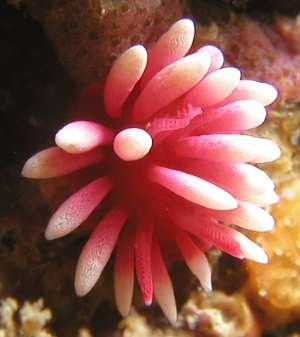
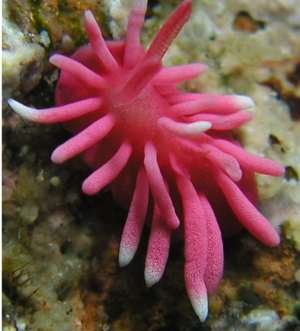
Thanks Yukari
Bill Rudman
Hopkinsia hiroi from Japan [3]
November 15, 2003
From: Yukari Sato
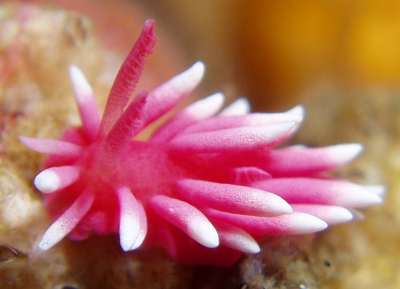
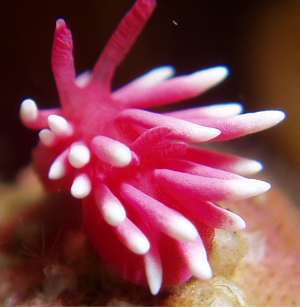
Hello Dr.Rudman,
Here are some more photos of Hopkinsia hiroi from Japan.
Date: 3 Aug 2003
Depth: 22m
Size: 7mm.
Location: Zushi (near Hayama), Sagami bay, Japan
Best regards,
Yukari Sato
yuks@cg7.so-net.ne.jp
Sato, Y., 2003 (Nov 15) Hopkinsia hiroi from Japan [3]. [Message in] Sea Slug Forum. Australian Museum, Sydney. Available from http://www.seaslugforum.net/find/11401Thanks Yukari,
Bill Rudman
Hopkinsia hiroi from Sth Korea
April 4, 2003
From: Dong Bum, Koh
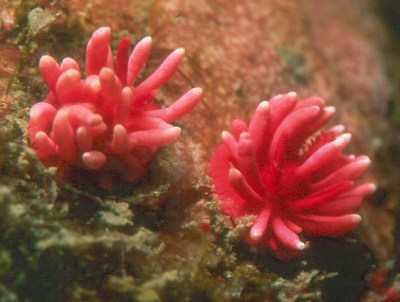
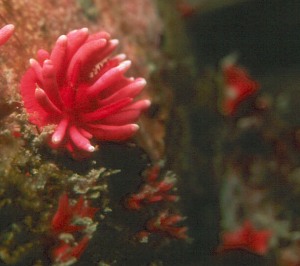
Dear Bill,
This is a photo of Hopkinsia hiroi for your Forum.
23 March 2003. 15m depth.
Moon islet in Jeju island. Sth Korea
Photographer: Dong Bum,Koh
Best regards,
Dong Bum, Koh
drkoh@seasee.co.kr
Koh, D.B., 2003 (Apr 4) Hopkinsia hiroi from Sth Korea. [Message in] Sea Slug Forum. Australian Museum, Sydney. Available from http://www.seaslugforum.net/find/9499Thanks Dong Bum,
I guess the little red branched colonies at the bottom of the photo are its food bryozoan.
Best wishes,
Bill Rudman
Hopkinisa hiroi - pale variety
August 10, 2001
From: Nishina Masayoshi
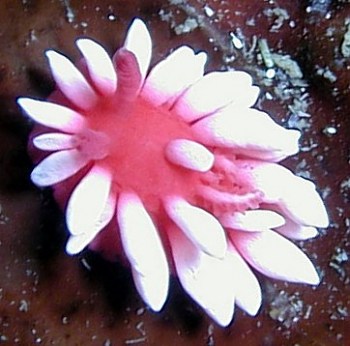
Dear Dr.Rudman,
Here are some photos of Hopkinsia hiroi with whitish cerata. Sometimes I see this colour variation here.
Date: 14 July 2001
Place: Enoura Beach (Sagami Bay), Japan
Depth: 6m
Size: 8mm
Comment: Common here
Photo by Nishina Chikako
Best Regards,
Nishina Masayoshi
nishina@hpe15.wips.co.jp
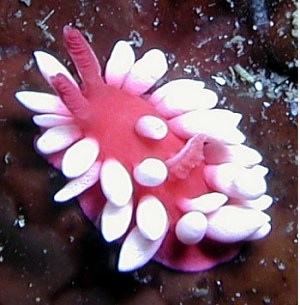
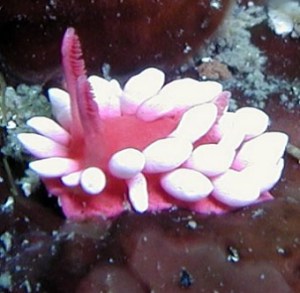
Dear Nishina & Chikako,
Thanks for these interesting photos
Best wishes,
Bill Rudman.
Hopkinsia hiroi from Sagami Bay, Japan
August 5, 2001
From: Nishina Masayoshi
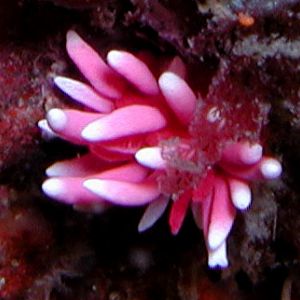
Dear Dr.Rudman,
Here is a photo of Hopkinsia hiroi that Chikako took on 7th July, 2001 at Enoura Beach, Sagami Bay, Japan.
Depth: 6m
Size: 10mm
Comment: Common here
Nishina Masayoshi
nishina@hpe15.wips.co.jp
Nishina, M., 2001 (Aug 5) Hopkinsia hiroi from Sagami Bay, Japan. [Message in] Sea Slug Forum. Australian Museum, Sydney. Available from http://www.seaslugforum.net/find/4974Thanks Nishina & Chikako,
It's good to get some photos of Japanese examples of this species.
Bill Rudman.
Hopkinsia hiroi from Hong Kong
August 3, 2001
From: Bill Rudman & Brian Darvell
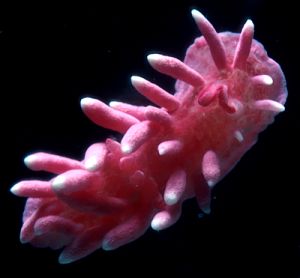
Here is some information and photos on Hopkinsia hiroi from Brian Darvell's Hong Kong collections.
This bright pink animal has a row of large finger-like papillae around the edge of the mantle. They are pink with a whitish tip. There is also one papilla in the centre of the back and a few extra on each side forming a sparse inner row of papillae. The few small pink gills form a row across the mantle just behind halfway. This species feeds on a similarly coloured pink encrusting bryozoan. It grows to 8 mm in length.
PHOTO:
UPPER RIGHT: Hong Kong, April 1983, Photo: B.E. Picton. LOWER LEFT: Hong Kong, Wai Kap Pai, Rocky Harbour, 23 Jan 1983, AM C138136. Photo: B. Darvell. LOWER RIGHT: Bryzoan prey of Hopkinsia Cape D'Aguilar Bay, Hong Kong, 5 April 1986. Photo: B. Darvell.
Hong Kong Collection Records:
AM C133758, 4 specimens, 18 April 1982, Site 4.8, Breaker Reef, Mirs Bay, 15 m. AM C138136, 2 specimens, 23 January 1983, Site 9.40, Wai Kap Pai, Rocky Harbour, 5-6 m. AM C139024, 10 April 1983, Site 4.57, Bate Head, Mirs Bay, 5-10 m. AM C139025, 4 specimens, 11 April 1983, Site 4.59, Gau Tau (N), Mirs Bay, 5-12 m. AM C142172, 31 March 1984, Site 10.99, Kiu Tau (W), Kiu Tsui Chau, Port Shelter, 6 m. Depth range: 2-19 m.
Reference:
• Rudman, W.B. & Darvell, B.W. (1990) Opisthobranch molluscs of Hong Kong. Part 1. Goniodorididae, Onchidorididae, Triophidae, Gymnodorididae, Chromodorididae, (Nudibranchia). Asian Marine Biology, 7: 31-79
Best wishes,
Bill Rudman & Brian Darvell
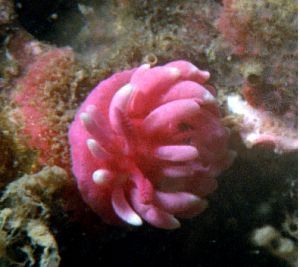

Hopkinsia hiroi from Hong Kong
August 3, 2001
From: Leslie Chan
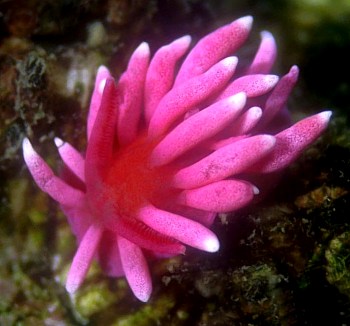
Dear Bill,
Could you identify this nudibranch which I photographed in Hong Kong.
Details: 12m, Ping Chau, Hong Kong. 31 January 2001.
Thanks
Leslie Chan
leslie@lesmart.com
Chan, L., 2001 (Aug 3) Hopkinsia hiroi from Hong Kong. [Message in] Sea Slug Forum. Australian Museum, Sydney. Available from http://www.seaslugforum.net/find/4775Dear Leslie,
This is Hopkinsia hiroi.
Best wishes,
Bill Rudman
